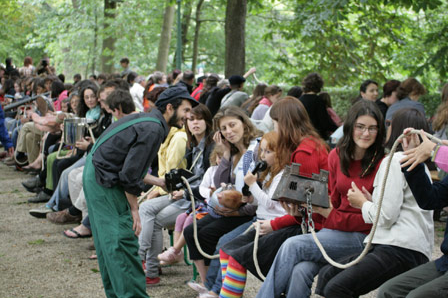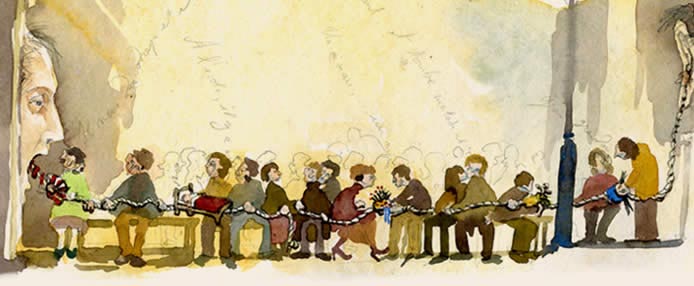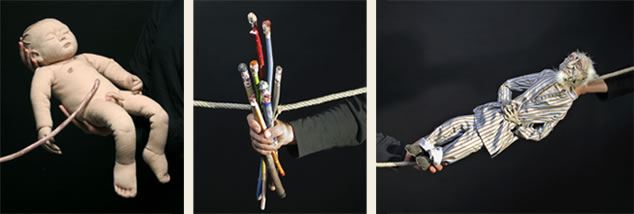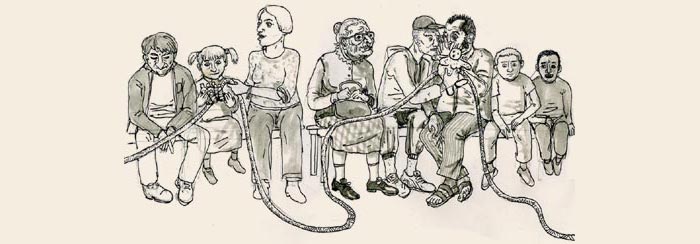Shows > By a Thread
By a Thread
All the versions of this article: [English] [français]

By a Thread tells the story of Odilon’s life, from his birth to his death, by evoking the transmission of anguish and values. The principle behind this interactive and dynamic show is simple and original. An actor hands an object to a first spectator and whispers a fragment of the story, which they then repeat to their neighbour. Thus, the objects start moving and, as they pass, everyone contributes to the epic story of Odilon.
To learn more

By a Thread, a street show, is based on an interfering device that is both visual and theatrical.
The rope makes material a link between actors, spectators and sculptures, but is also the thread of the story and communication.
All along the rope hang sculptures intended to be manipulated, sometimes with sound, sometimes animated, from a statuette to a jack-in-the-box. Each element comes with a sentence, launched by an actor, that the spectators must pass on at the same time as the objects. The text uses methods of oral games, anaphors or tongue-twisters; it’s designed to take into account what linguists call the “noise” in communication, referring to the alterations and misunderstandings as the text circulates. It recounts the life of Odilon, between modesty and frankness, love and disenchantment, from birth to death, evoking the transmission of anxiety and the that of values in the face of individual freedom. An exhibition of the sculptures that were used will close the show.

Technical requirements
Length of entire performance approximately 1 hour 20.
Length of performance for a spectator 45 min.
Capacity of 50 to 150 people: spectators come and go during the performance.
Number of artists 7.
Interior or exterior performance that can be staged in various quiet environments. Seats or benches must be provided, however, as well as a nearby backstage area.
This intimate show is designed to be performed outdoors, in the street, in a courtyard, on a square or green space. If desired, performances can also be held indoors, in a room, under a marquee or in a large stairwell. The venue must be quiet and far from any bothersome noise.
The capacity is highly variable, the only constraint being the ability to seat the audience during the performance, which is just under an hour for each spectator. Depending on the architecture of the place, this could be on the grass, on a low wall, or on benches and chairs provided by us or the organisers. As newcomers arrive they can join the ongoing performance; an actor will place them so that they will be at the beginning of the story. For the puppeteers and actors, the performance time will be about twenty seconds longer with each new spectator.
The ideal audience is a good hundred people. Above two hundred it would be better to schedule two performances.
Depending on the site, the show can be accessible to people in wheelchairs and the vision- impaired.
A version in sign language is also possible.
While the performance can be held in a variety of places, one or two backstage areas are necessary.
The first (provided by us in the form of a tent 12 m2 and 3 metres high) will be hidden by two textile bas-reliefs representing a mouth and an ear. The tent will contain and conceal the some sixty objects for the performance, arranged on six carriers. The rope will come out of the giant mouth and go back in by the giant ear after having been passed by the audience.
The second area, somewhat apart, will hide two four-metre tall puppets from the audience until the end of the performance.
The team includes seven people, actors, puppeteers and a stage manager.
Outside, the show is performed in daylight, with no sound system or lighting.
Inside, a stage lighting plan is available, it has no sound system and is fairly quiet.

A show by Christophe Evette and Jean-Baptiste Evette.
With Pauline de Coulhac, Christophe Evette, Cécile Favale, Fleur Marie Fuentes, Cédric Lasne, Laure Louvat and Raphaële Trugnan.
Objects made by Gaëlle Bauer • Dominique Bonnot • Jeanne Bouchart • Virginie Chevrier • Sylvia Clément • Ambra De Trapani • Pauline de Coulhac • Nadége Dulac, Jean-Baptiste Evette, Christophe Evette • Fleur Marie Fuentes • Karine Gualdaroni • Mandarine Jacquet Gregg • Yabaco Konaté • Thierry Lachambre • Cédric Lasne • Antonin Le Bras • Bethsabée Elharar Lemberg • Sarah Letouzey • Laure Louvat • Jean Martin • Aude Meeschaert • Mélanie Minaud • Marjorie Monnet • Frank Oettgen • Marie Paget • Madeleine Pornon • Nicolas Tauveron • Adrien Terrier • Nicolas Vuillier.
Coproducers: Nil Obsrat - Ville de Cergy - Festival Cergy Soit !
and the Villa Mais d’Ici
A few images from the very first performances with TVBIEN :





